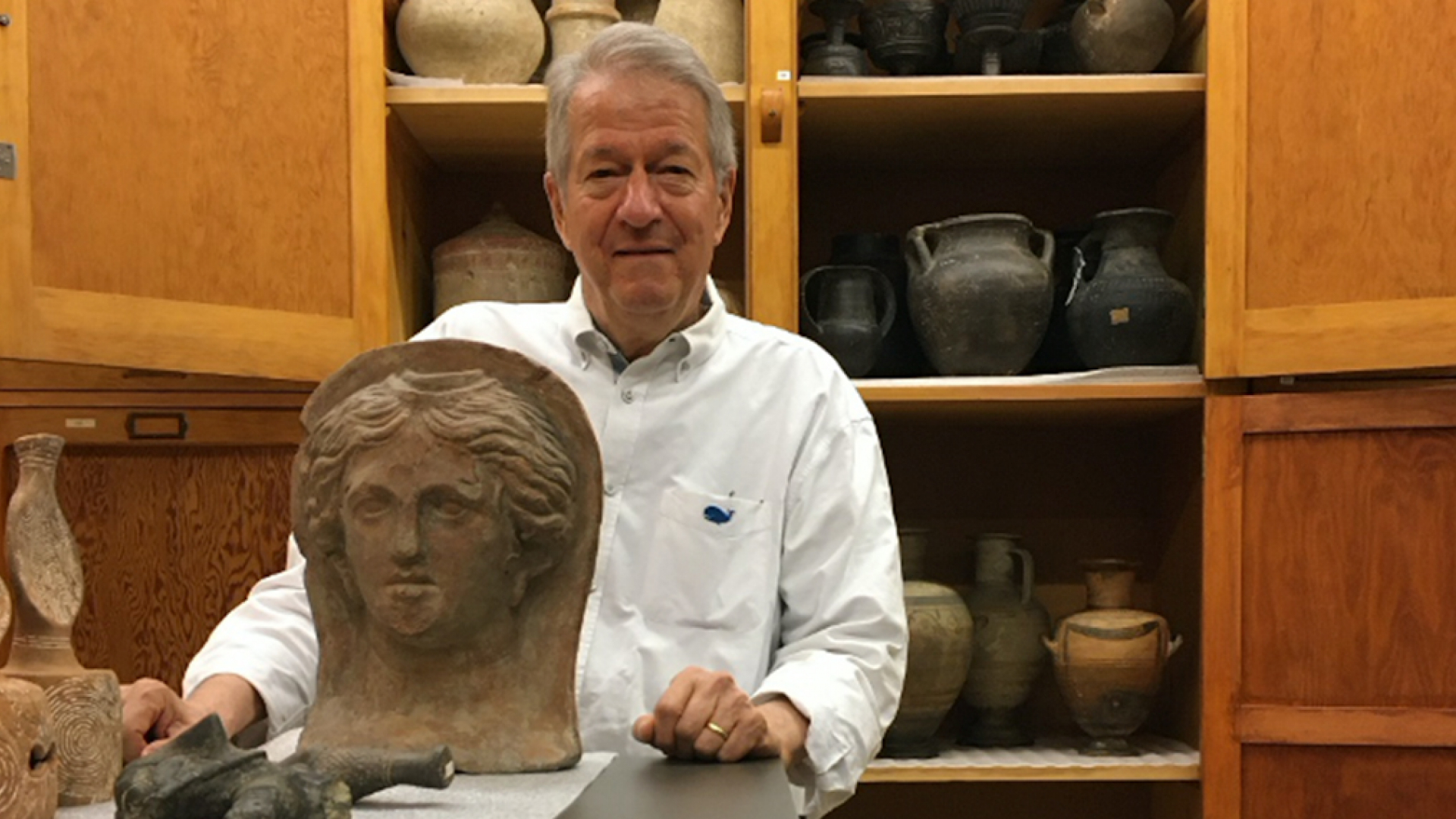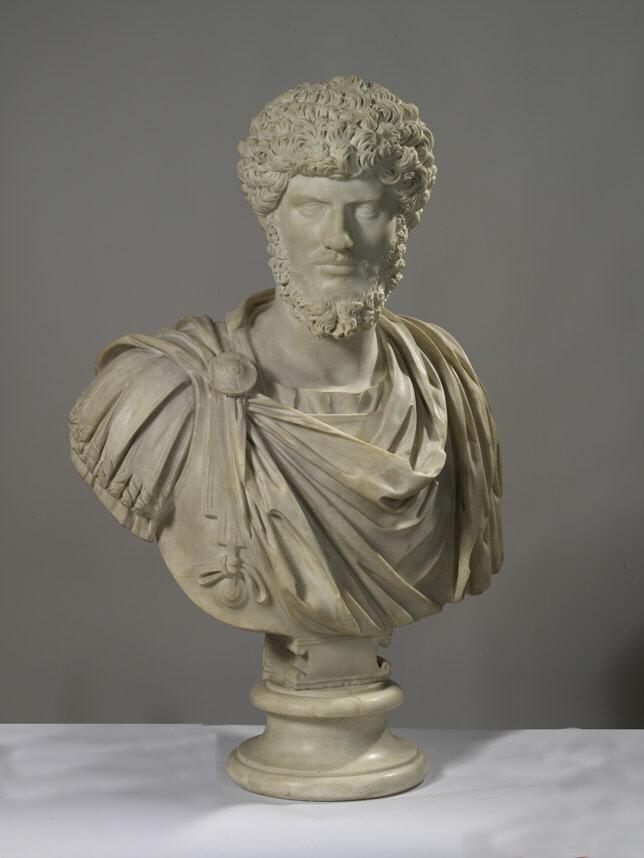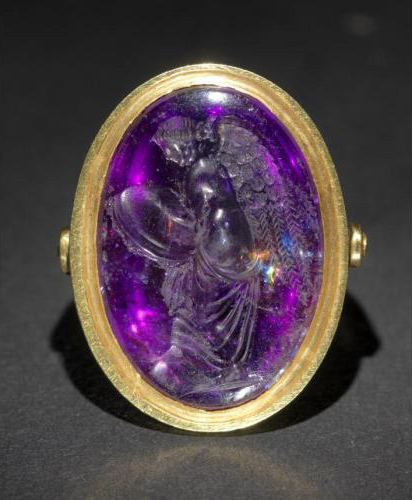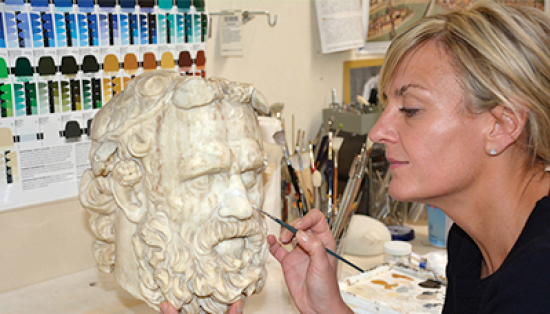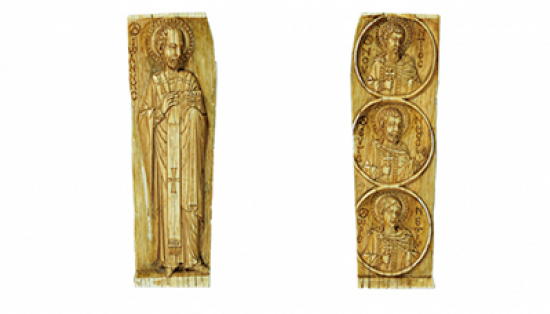Every Thursday at 10 am on Instagram we chat with a different ROM expert ready to answer your burning questions on a different subject. This time on Ask ROM Anything we are talking to Paul Denis.
Paul Denis is an Assistant Curator (Greek, Etruscan, Roman & Byzantine) at the Royal Ontario Museum. Originally interested in Greek sculpture, he has broadened his scope to include most aspects of Greek, Etruscan, Roman, and Byzantine art and culture. Generally, his work focuses on the associated research, preparation of objects for permanent galleries and temporary exhibitions. Over the last 30 years he has also focused on fundraising and the acquisition of artifacts for the ROM’s collections.
Paul was the lead curator responsible for the development of numerous permanent galleries, including The A.G Leventis Gallery of Ancient Cyprus; Bronze Age Aegean and Geometric Greece Gallery, the Eaton Gallery of Rome, the Bratty Family Gallery of Etruria, the Joey and Toby Tanenbaum Gallery of the Eastern Roman Empire, and the Joey and Toby Tanenbaum Gallery of Byzantium. These galleries highlight pieces from Canada’s most important collections of Greek, Etruscan, Roman, and Byzantine art. Paul has also curated temporary exhibitions including Gift of the Gods: The Art of Wine Revelry (2001), and Fakes and Forgeries: Past and Present (2010), an exhibition that examines the art of counterfeiting everything from antiquities to fossils to batteries to knockoff Dior purses.
Q. What factors prompted Rome to expand into the other regions around it?
A. During the early phases of its history, Rome’s early territorial growth was mainly defensive by conquering and defeating their Italic, Etruscan and Greek neighbours. These conquests brought Rome additional territory and wealth. During the Second Century BCE Rome also expanded to the East defeating the Hellenistic kings. Under Julius Caesar (died 44 CE), Rome expanded to the North capturing Gaul and Britain and part of Germania. These wars kept the so called “barbarians” in check, while the Romans extracted the natural wealth from these regions to fuel their industries at home. In summary, Rome expanded its territory for military defensive purposes and to extract the natural resources and wealth from the subdued regions. For example, after Egypt fell to the Romans, Egypt became the “breadbasket” of Rome.
Q. Aside from the Hellenic pantheon, what else did the Romans adopt from ancient Greeks?
A. Since I am an art historian, I will answer your question this way. The Romans also, in a big way, adopted ‘art’ from the Greeks, especially sculpture and painting. During the Republic, Rome had little art. But as Rome expanded in the 2nd century BC, the works of art of the defeated Greek cities poured into Rome as booty. Rome itself was soon captured by the beauty of Greek art and it became fashionable for wealthy Romans to decorate their homes and villas with Greek art and Roman copies of Greek originals. This included sculpture, silverware and paintings. Romans also used Greek art for political reasons – as propaganda. For example, Augustus (first Roman Emperor) adopted the art of Classical Athens (c. 450-400 BCE) to express the lofty ideals of his recently created Roman Empire.
Q. Were the same gods worshiped throughout the Roman empire, or were there regional differences?
A. Yes, the same Roman gods were worshiped throughout the empire, Jupiter was especially important in the city of Rome. The Romans were tolerant and allowed the local inhabitants to worship their own gods. There were also “Mystery Religions” in the Empire. Two of these religions were the worship of Isis and Mithra. The cult of Isis started in Egypt and flourished throughout the Empire. A Temple of Isis is still preserved in Pompeii. The worship of Mithra was another popular cult, called Mithraism, that took place in the Mithraeum. This cult started in the East and spread all the way to Britain. It was especially popular with soldiers. These mystery cults were popular because they promised life after death. Christianity grew steadily after the religion’s birth in Judea. Christians were persecuted by various Emperors and so the religion went underground. The Emperor Constantine I officially recognized Christianity in 313 CE and the religion grew throughout the Empire.
Q. Are many features of Greek democracy still used today?
A. I am not an expert on Athenian democracy but let me try to answer your question. I guess the only feature that is similar is the idea of ‘voting’.
In Athens democracy was ‘direct democracy’ a citizen went to the assembly and voted on an issue. If they voted to go to war, the citizen would go to war. Today, we have a ‘representative democracy’ we vote for representatives who make decisions and if they vote to go to war, then an army is sent.
In Athens only male citizens could become part of the government. Women, foreigners and slaves could not vote or attended the councils. It was more like a select club only open to Athenian male citizens.
Today in Canada, voting is open to every Canadian citizen 18 years and older.
Q. Do you have a favourite deity?
A. Yes, my favorite deity is the goddess Athena. The patron goddess of the city of Athens and the goddess of wisdom, learning, the arts and crafts, and war. She was popular throughout Greece but her most important site of worship was on the acropolis in the city of her name-sake - Athens. The Greeks built a famous temple on the acropolis, the Parthenon, in the late 5th century BC. The sculpture used to decorate the Parthenon remains the most beautiful art ever produced. The Athenians also used an image of the head of Athena on their coins and on the back of the coins they used an image of an owl – the symbol of wisdom and learning.
Q. How can you tell the difference between a Greek statue and a Roman statue?
A. In antiquity, a lot of free-standing Greek sculpture was made from bronze, although marble was used for tombstones and architectural decorations. Original bronze Greek sculpture is extremely rare because most of it was melted down. However, the Romans, who loved Greek art, did make marble copies of Greek original bronze sculpture. That is why and how we can identify lost Greek originals through their marble Roman copies. Such as the famous statue of the Doryphoros by the Greek sculptor Polyclitus, which exists in several marble Roman copies.
The Greeks did carve marble sculpture and distinguishing it from a similar looking Roman sculpture takes many years of study and looking at Greek and Roman sculpture and having a ‘good eye’. Generally, Greek marble sculpture tends to have rather soft features, such as the modelling of the face. While with Roman sculpture the features tend to be harsher and the modelling looks more mechanical less natural.
Q. Did romans really use geese as guard animals?
A. Here is the only ancient story I know about geese. Geese were a sacred bird of Juno and were kept and fed on the Capitoline Hill. Apparently, a flock of Juno’s geese saved the Roman Republic from the invasion of Gauls in 390 BCE. The Gallic invaders were sneaking up the Capitoline hill when they disturbed a flock of geese living in the temple of Juno. Their honking alerted the Romans who then repelled the Gauls.
I Googled Geese and I came up with: “Geese have been used as guardian animals for centuries. Why? Because they are uniquely suited to the task. Not only are their piercing honks excellent alarms, but they are instinctively protective and more naturally suited to guard work than humans, or even dogs.”
Q. How long would it take a mosaicist to finish a piece like the ones found in Herculaneum or Pompeii?
A. Good question! It would depend on the size and the fineness of the mosaic. A mosaic was laid by a skilled team of artisans led by a master craftsman. They likely started from stock images in a pattern book that the owner of the building (floor) would choose from. First, the foundation had to be prepared with different layers of rubble and stones. Then, the colourful cut stones (tesserae) would be set into the bedding of mortar to form the desired image. I did some research and none of the source specifically stated how long it would take to lay a mosaic floor in Antiquity. The people who made the mosaics were well trained and efficient and so I believe they could work quickly.
Q. Do you have a favourite Roman emperor?
A. Yes, the Emperor Augustus, who reigned from 27 BC to AD 14. He founded the Roman Empire and was accepted by the Senate. Unlike Caesar, who had distain for the Senate, Augustus was an astute politician and he showed them respect and included them in his government. Also, during the time of Augustus, Roman artists created some of Rome’s most beautiful art evident in Roman portraiture, sculpture like the Ara Pacis, wall paintings, silver ware and engraved gems.
Q. Is there a specific piece of artwork in the ROM collection that takes your breath away?
A. The marble portrait of the Co-Emperor Lucius Verus (about AD 161-169) is spectacular (acc. no. 933.27.3). The marble is of very fine quality and carved by a very skilled sculptor who captured the pomp, extravagance, and dignity of the Emperor. Note the high quality of the drill work that forms his curly hair and beard and the skilled modelling of Lucius’ face. This is one of the finest portraits of Lucius Verus in any museum in the world and certainly, the finest Roman portrait in Canada. It was bought at auction by the ROM in 1933.
Q. How accurate are depictions of ancient Greece and Rome on TV and film? Are there any you would consider very accurate?
A. Not really, the depictions try to be accurate, but they tend to be overblown. In many films the details are sometimes correct but then the producers make pastiches and create weird objects and scenes. The movies are made for mass consumption and to make money. I like Russell Crowe in the Gladiator, especially the opening scene when the Roman army battles the Celts. The recent movie about Pompeii with Kiefer Sutherland is so bad, it is good!
Q. Can you tell me more about this carved amethyst in the ROM online collection?
A. This is one of my favorite gems. It is very finely engraved with a winged Victory (in Greek: Nike), the goddess of victory in war. Here she is inscribing the names of the battles won by the Emperor Augustus on to a shield. We can date the carving by its beautiful style and the super fine workmanship which are features of gems carved during the time of Augustus (first Roman Emperor, c 30 BC). It has a wonderful provenance (collecting history) traced back to the 16th century. It was bought by the ROM at a Christies auction in 1925. If you would like more info, please send us a note and I can forward you an article I wrote on this gem.
Q. What piece of Greek/Roman art at the ROM has the most interesting origin story?
A. An interesting provenance (collecting history) is that of an amethyst engraved with the image of a Victory writing on a shield (acc. no. 925.83.6 see image online collections). It was bought by the ROM in 1925 at auction. After it came to the ROM, it soon disappeared. The gem was re-discovered in 2012 in the storage cabinets of the European section. After doing some provenance research I found out that it had once belonged to Sir Francis Cook during the late 19th century. A colleague in Germany recognized the gem and she helped to complete the provenance story of the gem. It was first owned by Paulus von Praun of Nuremberg during the 16th century. The gem was next seen in the collection of Sibylle Mertens-Schaaffhausen of Bonn, in the early 19th century. After her death, the gem was acquired by Sir Francis Cook and eventually his grandson Humphrey Cook sold it at auction in 1925, when it was purchased by the ROM. After it first came to the ROM, it was thought to be a 19th century gem and so it was banished to the European storage cabinets. However, after research I was able to correct the mistake and the gem is now properly catalogued as being early Roman Imperial dating to about 25 BC to AD 25. The rediscovery of this lost masterpiece was very satisfying. If you want a more detailed account, send us a line and we can forward you an article I wrote on the gem.

